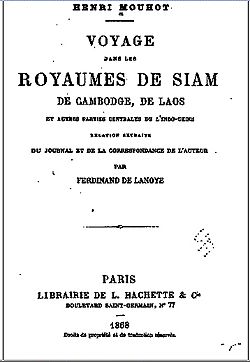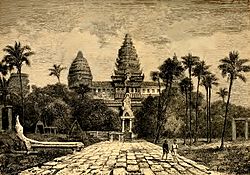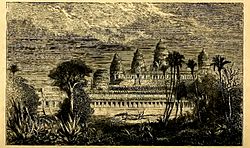Henri Mouhot facts for kids
Quick facts for kids
Henri Mouhot
|
|
|---|---|
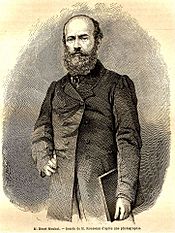
A drawing of Henri Mouhot done by H. Rousseau from a photograph
|
|
| Born | May 15, 1826 Montbéliard, Doubs, France
|
| Died | November 10, 1861 (aged 35) Naphan, Laos
|
| Nationality | French |
| Known for | Angkor |
| Scientific career | |
| Fields | Natural history |
Henri Mouhot (born May 15, 1826 — died November 10, 1861) was a French naturalist and explorer. He lived in the mid-1800s. Henri was born in Montbéliard, France. He spent some of his childhood in Russia and possibly parts of Asia. He is mostly remembered for his work connected to Angkor. Mouhot passed away near Naphan, Laos. His tomb is located near Ban Phanom, east of Luang Prabang.
Contents
Henri Mouhot's Early Life
Henri Mouhot traveled across Europe with his brother, Charles. They studied new ways of taking pictures, called photographic techniques. In 1856, Henri started to focus on studying natural science. This is the study of nature and living things.
In 1857, he read a book by Sir John Bowring about Siam (now Thailand). This book made Mouhot want to travel to Indochina. He hoped to collect new animal and plant samples there. French companies and the government did not want to help him at first. But the Royal Geographical Society and the Zoological Society of London supported his trip. So, he sailed to Bangkok, stopping in Singapore along the way.
Mouhot's Expeditions
From his base in Bangkok in 1858, Mouhot went on four trips. He explored parts of Siam, Cambodia, and Laos. For three years, he faced many challenges. He dealt with wild animals and explored parts of the jungle that no one from Europe had mapped before.
On his first trip, he visited Ayutthaya. This was the old capital of Siam. He collected many insects, as well as land and river shells. He sent all these samples back to England.
In January 1860, he reached Angkor. This was during his second and longest journey. Angkor is a huge area, more than 400 square kilometers. It has many ancient sites like terraces, pools, and temples. The most famous temple is Angkor Wat. Mouhot wrote about his visit in his travel journals. He spent three weeks making detailed notes and drawings. These journals were later published after he died. The book was called Voyage dans les royaumes de Siam, de Cambodge, de Laos.
Angkor: Not a "Lost City"
Many people mistakenly think Henri Mouhot "discovered" Angkor. However, Angkor was never truly lost. The people of Cambodia, called the Khmers, always knew about these ancient sites. Several Westerners had also visited Angkor since the 1500s.
Mouhot himself wrote in his journals about other visitors. He mentioned Father Charles Emile Bouillevaux, a French missionary. Father Bouillevaux and other Western explorers had visited Angkor Wat years before Mouhot. Father Bouillevaux even published his own travel stories in 1857. A Portuguese trader, Diogo do Couto, wrote about Angkor in 1550. And a Portuguese monk, Antonio da Magdalena, visited in 1586. Mouhot's writings, however, made Angkor very famous in the Western world.
Mouhot's descriptions were very vivid. He included interesting and detailed drawings. In his book, Travels in Siam, Cambodia and Laos, he compared Angkor to the pyramids of Egypt. He described the Buddha heads at Angkor Thom as "four immense heads in the Egyptian style." He also wrote about Angkor:
"One of these temples—a rival to that of Solomon, and built by some ancient Michelangelo—might take an honorable place beside our most beautiful buildings. It is grander than anything left to us by Greece or Rome."
Mouhot also wrote:
"At Ongcor, there are ...ruins of such grandeur... that, at the first view, one is filled with deep admiration. One cannot help but ask what has become of this powerful race, so civilized, so enlightened, the builders of these giant works?"
These words might have made people think Mouhot found the ruins of a "lost civilization." The Royal Geographical Society and The Zoological Society had sponsored Mouhot. They seemed to encourage the idea that he had discovered Angkor. Mouhot himself wrongly believed that Angkor was built by a civilization older than the Khmer people. He thought the people living there were "barbaric" and could not have built such grand structures. He guessed Angkor was over two thousand years old, around the same time as ancient Rome.
The real history of Angkor Wat was later put together. This was done using a book called The Customs of Cambodia. It was written by Zhou Daguan, a Chinese envoy, in 1295-1296. Also, clues from the building styles and old writings helped. We now know that Angkor was lived in from the early 800s to the early 1400s.
Mouhot and Colonialism
Some people have suggested that Mouhot's work helped France expand its power. This expansion happened soon after he died. However, Mouhot himself did not seem to be a strong supporter of colonialism. He sometimes wondered if European colonization was truly good:
"Will the present movement of the nations of Europe towards the East result in good by introducing into these lands the blessings of our civilization? Or shall we, as blind instruments of boundless ambition, come hither as a scourge, to add to their present miseries?"
This quote shows he had doubts about the impact of European countries on other lands.
Death and Legacy
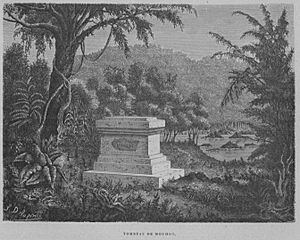
Henri Mouhot died from malarial fever during his fourth expedition. He was in the jungles of Laos. He had been visiting Luang Prabang, the capital of the Lan Xang kingdom. This kingdom was one of three that later became modern-day Laos. Two of his servants buried him near a French mission in Naphan. Mouhot's favorite servant, Phrai, took all of Mouhot's journals and samples back to Bangkok. From there, they were sent to Europe.
A small monument was built over his grave in 1867. French commander Ernest Doudart de Lagrée ordered it. He praised Mouhot, saying:
"We found everywhere the memory of our compatriot who, by the uprightness of his character and his natural benevolence, had acquired the regard and the affection of the natives."
The first monument was washed away by the Nam Khan river. A stronger monument was built in 1887. A small house was also built nearby for visitors. The French School of the Far East (EFEO) did some repair work on the tomb in 1951.
Mouhot's tomb was lost in the jungle until 1989. A French scholar, Jean-Michel Strobino, accidentally found it again. He helped restore it with support from the French embassy and Mouhot's hometown, Montbeliard. A new plaque was added to the tomb in 1990 to remember its rediscovery. Today, hotels and tour companies in Luang Prabang know where the tomb is. You can hire a minivan or "tuk tuk" to visit it. The path to the tomb can be slippery after rain, so good shoes are important.
Mouhot's writings made Angkor very popular. This led to a lot of support for France to study and protect the site. The French did most of the research on Angkor until recently.
Two types of Asian reptiles are named after him: Cuora mouhotii, a turtle, and Oligodon mouhoti, a snake.
See also
 In Spanish: Henri Mouhot para niños
In Spanish: Henri Mouhot para niños


